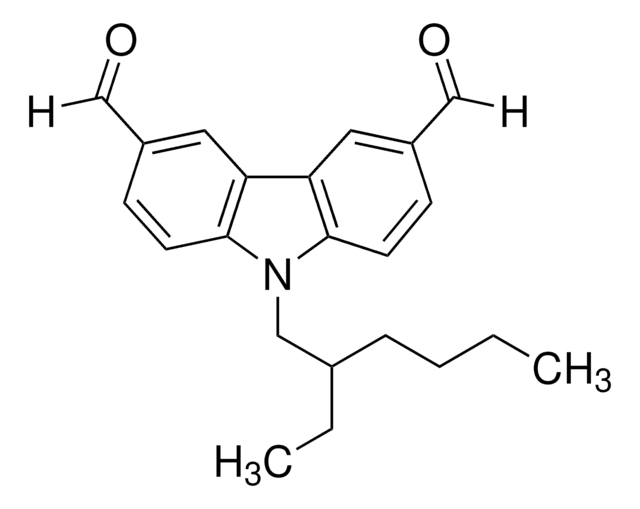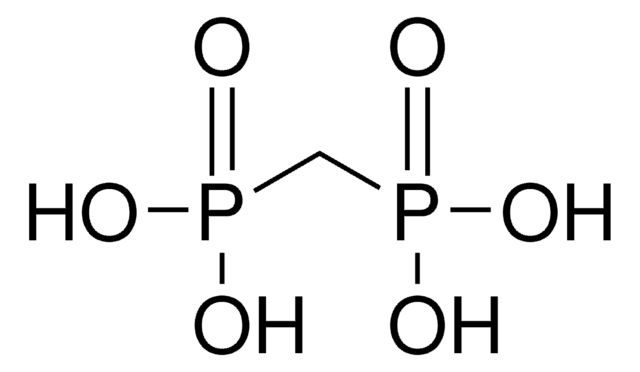68221
Abberior® STAR 440SXP, NHS ester
for long Stokes STED and 2-color STED application
Autenticatiper visualizzare i prezzi riservati alla tua organizzazione & contrattuali
About This Item
Codice UNSPSC:
12352108
NACRES:
NA.32
Prodotti consigliati
Saggio
≥80.0% (degree of coupling)
Stato
solid
PM
Mw 597.5 g/mol
Solubilità
DMF: 1 mg/mL, clear
Fluorescenza
λex 440 nm; λem 511 nm±10 nm in PBS, pH 7.4
Temperatura di conservazione
−20°C
Descrizione generale
Absorption Maximum, λmax: 433 nm (MeOH)
432 nm (PBS, pH 7.4)
Extinction Coefficient, ε(λmax): 36,000 M-1cm-1 (MeOH)
33,000 M-1cm-1 (PBS, pH 7.4)
Correction Factor, CF260 = ε260/εmax: 0.47 (PBS, pH 7.4)
Correction Factor, CF280 = ε280/εmax: 0.31 (PBS, pH 7.4)
Fluorescence Maximum, λfl: 502 nm (MeOH),
511 nm (PBS, pH 7.4)
Recommended STED Wavelength, λSTED: 590 − 620 nm
Fluorescence Quantum Yield, η: 0.57 (PBS, pH 7.4)
Fluorescence Lifetime, τ: 3.7 ns (PBS, pH 7.4)
432 nm (PBS, pH 7.4)
Extinction Coefficient, ε(λmax): 36,000 M-1cm-1 (MeOH)
33,000 M-1cm-1 (PBS, pH 7.4)
Correction Factor, CF260 = ε260/εmax: 0.47 (PBS, pH 7.4)
Correction Factor, CF280 = ε280/εmax: 0.31 (PBS, pH 7.4)
Fluorescence Maximum, λfl: 502 nm (MeOH),
511 nm (PBS, pH 7.4)
Recommended STED Wavelength, λSTED: 590 − 620 nm
Fluorescence Quantum Yield, η: 0.57 (PBS, pH 7.4)
Fluorescence Lifetime, τ: 3.7 ns (PBS, pH 7.4)
Applicazioni
- Abberior® STAR 440SXP goat anti-mouse antibody has been used for STED (stimulated emission depletion) microscopy imaging of primary hippocampal cells.
- Secondary anti-mouse antibody conjugated with Abberior® STAR 440SXP has been used for gated STED microscopy imaging of viral capsid.
- Abberior® STAR 440SXP goat anti-rabbit antibody has been used for two-color STED microscopy imaging of olfactory epithelium.
Compatibilità
Designed and tested for fluorescent super-resolution microscopy
Altre note
Note legali
abberior is a registered trademark of Abberior GmbH
Prodotti correlati
N° Catalogo
Descrizione
Determinazione del prezzo
Codice della classe di stoccaggio
11 - Combustible Solids
Classe di pericolosità dell'acqua (WGK)
WGK 3
Punto d’infiammabilità (°F)
Not applicable
Punto d’infiammabilità (°C)
Not applicable
Scegli una delle versioni più recenti:
Possiedi già questo prodotto?
I documenti relativi ai prodotti acquistati recentemente sono disponibili nell’Archivio dei documenti.
I-Hsuan Wang et al.
Cell host & microbe, 14(4), 468-480 (2013-10-22)
Viral DNA trafficking in cells has large impacts on physiology and disease development. Current methods lack the resolution and accuracy to visualize and quantify viral DNA trafficking at single-molecule resolution. We developed a noninvasive protocol for accurate quantification of viral DNA-genome
Linda Westin et al.
BMC neuroscience, 15, 45-45 (2014-03-29)
Norbin is a neuron-specific, cytosolic protein that interacts with the metabotropic glutamate receptor 5 (mGluR5) and has a profound impact on mGluR5 signaling. Yet, little is known about its synaptic distribution. Here we have analyzed the spatial relationship between Norbin
Bastian Henkel et al.
Chemical senses, 40(2), 73-87 (2014-12-17)
Vertebrates can sense and identify a vast array of chemical cues. The molecular machinery involved in chemodetection and transduction is expressed within the cilia of olfactory sensory neurons. Currently, there is only limited information available on the distribution and density
S W Hell et al.
Optics letters, 19(11), 780-782 (1994-06-01)
We propose a new type of scanning fluorescence microscope capable of resolving 35 nm in the far field. We overcome the diffraction resolution limit by employing stimulated emission to inhibit the fluorescence process in the outer regions of the excitation
Marcus Dyba et al.
Nature biotechnology, 21(11), 1303-1304 (2003-10-21)
We report immunofluorescence imaging with a spatial resolution well beyond the diffraction limit. An axial resolution of approximately 50 nm, corresponding to 1/16 of the irradiation wavelength of 793 nm, is achieved by stimulated emission depletion through opposing lenses. We
Il team dei nostri ricercatori vanta grande esperienza in tutte le aree della ricerca quali Life Science, scienza dei materiali, sintesi chimica, cromatografia, discipline analitiche, ecc..
Contatta l'Assistenza Tecnica.



